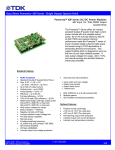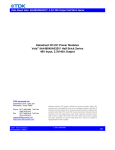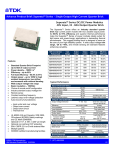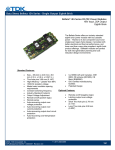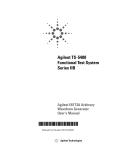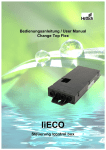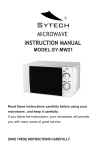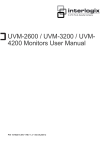Download TDK Xeta Half Brick-iHG User's Manual
Transcript
Data Sheet: Xeta iHG48070A033V, 3.3V/70A Output Half Brick Series Datasheet DC-DC Power Modules Xeta iHG Half Brick 48V Input, 3.3V/70A Output TDK Innoveta Inc. 3320 Matrix Drive, Suite 100 Plano, Texas 75082 Phone (877) 498-0099 Toll Free (469) 916-4747 Fax (877) 498-0143 Toll Free (214) 239-3101 [email protected] http://www.tdkinnoveta.com/ ©2008 TDK Innoveta Inc. iHG Datasheet 2008-05-15 Revision 1.1 Information furnished by TDK Innoveta is believed to be accurate and reliable. However, TDK Innoveta assumes no responsibility for its use, nor for any infringement of patents or other rights of third parties, which may result from its use. No license is granted by implication or otherwise under any patent or patent rights of TDK Innoveta. TDK Innoveta components are not designed to be used in applications, such as life support systems, wherein failure or malfunction could result in injury or death. All sales are subject to TDK Innoveta’s Terms and Conditions of Sale, which are available upon request. Specifications are subject to change without notice. ℡ (877) 498-0099 1/16 Data Sheet: Xeta iHG48070A033V, 3.3V/70A Output Half Brick Series Platform Overview: Xeta iHG48 Series DC-DC Power Modules 48V Input, 3.3V / 70A Output Half-Brick The Xeta iHG48 Series power modules operate over a wide 36 – 75Vdc input voltage range and provide one regulated dc output voltage that is electrically isolated from the input. The single board open-frame type design with high conversion efficiency (up to 92%), and superior thermal performance make iHG series modules ideally suited for high power, low air flow telecom applications in demanding thermal environments. A wide output voltage trim range, -50 to 10%, and remote sensing are standard features enhancing versatility. Standard Features: • • • • • • • • • • • • RoHS compliant Standard Half Brick footprint Optimized output power: 231W Full load efficiency, 90% typical Wide output trim voltage range Up to 70A of true usable current Single board design 52A at 65°C, 200LFM (no base-plate) Monotonic start-up into a pre-biased output bus Remote sense Basic insulation – 1500 Vdc Constant switching frequency Auto-recovery protection: o o o o o Input UV protection Output over voltage Output over current Short circuit Thermal protection ©2008 TDK Innoveta Inc. iHG Datasheet 2008-05-15 Revision 1.1 • • • • High reliability open frame, surfacemount construction Open frame for improved thermal management UL 60950 (US and Canada), VDE 0805, CB scheme (IEC950), CE Mark (EN60950) Multiple patents Optional Features: • • • • Latched output over voltage protection Latched output over current protection Latched over temperature protection Base-plate ℡ (877) 498-0099 2/16 Data Sheet: Xeta iHG48070A033V, 3.3V/70A Output Half Brick Series Ordering information: Product Identifier Package Size Platform Input Voltage i H G 48 Output Current/ Power 070 TDK Innoveta Half Brick Xeta 36-75V 70 Feature Set 000 On/Off Logic Positive Omit pin3 Yes 001 Negative 002 003 A Main Output Voltage 033 Amps 033 – 3.3V Output Units # of Outputs V Single Mechanical Feature - 0 0 - No base plate 1- With base plate Auto-Recovery Pin Length 0.145” Baseplate No Auto-Recovery Auto-Recovery 0.145” No Auto-Recovery Auto-Recovery Auto-Recovery 0.145” No Auto-Recovery Auto-Recovery Auto-Recovery 0.145” No Output OVP Output OCP Latching Auto-Recovery Yes Latching Positive Yes Negative Yes OTP Electrical Feature Set 02 02-R Standard, RoHS Compliant OVP: Over Voltage Protection; OCP: Over Current Protection; OTP: Over Temperature Protection. Product Offering: Code Input Voltage Output Voltage Output Current Maximum Output Power Efficiency iHG48070A033V-002-R 36V to 75V 3.3V 70A 231W 90% TDK Innoveta Inc 3320 Matrix Drive, Suite 100 Richardson, Texas 75082 Phone (877) 498-0099 Toll Free (469) 916-4747 Fax (877) 498-0143 Toll Free (214) 239-3101 [email protected] http://www.tdkinnoveta.com/ ©2008 TDK Innoveta Inc. iHG Datasheet 2008-05-15 Revision 1.1 ℡ (877) 498-0099 3/16 Data Sheet: Xeta iHG48070A033V, 3.3V/70A Output Half Brick Series Mechanical Specification: Dimensions are in mm [in]. Unless otherwise specified tolerances are: x.x ± 0.5 [0.02], x.xx and x.xxx ± 0.25 [0.010]. 1.02 [0.040] Dia Pin 1.83 [0.072] Dia Stand-off 6 Places 1 9 2 8 7 2.03 [0.080] Dia Pin 3.00 [0.118] Dia Stand-off 2 Places 6 4 5 Recommeded hole pattern (top view) Pin Assignment: PIN 1 2 3 4 5 6 FUNCTION PIN FUNCTION Vin (+) On/Off N/A Vin (-) Vout (-) Sense (-) 7 8 9 Trim Sense (+) Vout (+) Pin base material is copper with matte tin plating. The maximum module weight is 63g. ©2008 TDK Innoveta Inc. iHG Datasheet 2008-05-15 Revision 1.1 ℡ (877) 498-0099 4/16 Data Sheet: Xeta iHG48070A033V, 3.3V/70A Output Half Brick Series Absolute Maximum Ratings: Stress in excess of Absolute Maximum Ratings may cause permanent damage to the device. Characteristic Min Max Continuous Input Voltage -0.5 80 Vdc Unit Transient Input Voltage --- 100 Vdc Isolation Voltage --- 1500 Vdc Storage Temperature -55 125 ˚C Operating Temperature Range (Tc) -40 123 ˚C * Notes & Conditions 100mS max. Measured at the location specified in the thermal measurement figure. Engineering estimate Input Characteristics: Unless otherwise specified, specifications apply over all Rated Input Voltage, Resistive Load, and Temperature conditions. Characteristic Min Typ Max Operating Input Voltage 36 48 75 Unit Maximum Input Current --- --- 8 A Turn-on Voltage --- 34.2 36 Vdc Turn-off Voltage --- 32.5 --- Vdc Hysteresis --- 1.7 --- Vdc Startup Delay Time from application of input voltage --- 8 --- mS Startup Delay Time from on/off --- 3 --- mS Output Voltage Rise Time --- 24 --- mS Standby Current 0 5 7 mA Inrush Transient --- --- 0.1 A2s Input Reflected Ripple --- 14 --- mApp Input Ripple Rejection --- 60 --- dB Notes & Conditions Vdc Vin = 0 to Vin,max, Io,max, Vo=Vo,nom Vo = 0 to 0.1*Vo,nom; on/off =on, Io=Io,max, Tc=25˚C Vo = 0 to 0.1*Vo,nom; Vin = Vi,nom, Io=Io,max,Tc=25˚C Io=Io,max,Tc=25˚C, Vo=0.1 to 0.9*Vo,nom Vin=0V to Vin,max and module on/off pin is in ‘off’ state See input/output ripple measurement figure; BW = 20 MHz @120Hz * Engineering Estimate Caution: The power modules are not internally fused. An external input line normal blow fuse with a maximum value of 15A is required; see the Safety Considerations section of the data sheet. ©2008 TDK Innoveta Inc. iHG Datasheet 2008-05-15 Revision 1.1 ℡ (877) 498-0099 5/16 Data Sheet: Xeta iHG48070A033V, 3.3V/70A Output Half Brick Series Electrical Data (continued): Operating at Tc = 25˚C unless otherwise specified Characteristic Min Typ Max Unit Output Voltage Initial Setpoint 3.25 3.3 3.35 Vdc Vin=Vin,nom; Io=Io,max Notes & Conditions Output Voltage Tolerance 3.2 --- 3.4 Vdc Efficiency --- 90 --- % Over all rated input voltage, load, and temperature conditions to end of life Vin=Vin,nom; Io=Io,max Line Regulation --- 3 10* mV Load Regulation --- 1 10* mV Io=Io,min to Io,max Temperature Regulation --- 20 50* mV Tc=Tc,min to Tc,max Output Current 0 --- 70 A Output Current Limiting Threshold --- 82 --- A Short Circuit Current --- 2 --- A Output Ripple and Noise Voltage --- 25 50* mVpp --- 5.5 --- mVrms Output Voltage Adjustment Range 50 --- 110 %Vo,nom Output Voltage Sense Range --- --- --- %Vo,nom Dynamic Response: Recovery Time --- 200 --- µS Transient Voltage --- 70 --- mV Vin=Vin,min to Vin,max At Io < 20% of Io,max, the load transient performance may degrade slightly Vo = 0.9*Vo,nom, Tc < Tc,max Vo = 0.25V, Tc = 25C (hiccup mode) Vin=48V and Tc=25˚C. Measured across one 10uF, one 0.47uF, one 0.1uF ceramic capacitors, and one 220uF electrolytic capacitor – see input/output ripple measurement figure; BW = 20MHz Vin=Vin,nom; load step from 50% to 75% of Io,max, di/dt = 0.1A/uS, with at least one 0.1uF, one 0.47uF, one 10uF ceramic capacitors, and 220uF electrolytic capacitor across the output terminals Output Voltage Overshoot during startup 0 0 0 mV For applications with large step load changes and/or high di/dt load changes, please contact TDK Innoveta for support. Io=Io,max Switching Frequency --- 260 --- kHz Fixed 3.8* 230 4.1 --- 4.4* 40,000** V All line, load, and temperature conditions uF Isolation Capacitance --- 2000 --- pF All charge and pre-bias start conditions. Cext,min required for the 100% load dump. Minimum ESR > 2 mΩ All line, load, and temperature conditions Isolation Resistance 15 --- --- MΩ V Output Over Voltage Protection External Load Capacitance Vref 1.225 All line, load, and temperature conditions Required for trim calculation * Engineering Estimate ** Contact TDK Innoveta for applications that require additional capacitance ©2008 TDK Innoveta Inc. iHG Datasheet 2008-05-15 Revision 1.1 ℡ (877) 498-0099 6/16 Data Sheet: Xeta iHG48070A033V, 3.3V/70A Output Half Brick Series Electrical Characteristics: 94 35 30 P o w e r D is s ip a tio n (W ) E ffic ie n c y (% ) 90 86 82 78 74 7 14 21 28 35 42 49 56 63 70 25 20 15 10 5 0 7 14 21 Vin = 48V Vin = 75V 35 42 49 56 63 Vin = 60V Vin = 36V Vin = 48V Vin = 75V Vin = 60V Efficiency vs. Input Voltage at Ta=25C, (test in socket) Power Dissipation vs. Input Voltage at Ta=25C Start-up from on/off Switch at 48V input and Full Load. Ch. 1: ON/OFF Ch. 3: Vo Ch. 4: Io Typical Output Ripple at 48V Input and Full Load at Ta=25C Ch. 3: Vo Start-up from Input Voltage Application at Full Load. Ch. 1: Vin Ch. 3: Vo Ch. 4: Io Load Transient Response. Load Step from 50% to 75% of Full Load with di/dt= 0.1A/uS. Ch. 1: Vo Ch. 3: Io ©2008 TDK Innoveta Inc. iHG Datasheet 2008-05-15 Revision 1.1 70 Output Current (A) Output Current (A) Vin = 36V 28 ℡ (877) 498-0099 7/16 Data Sheet: Xeta iHG48070A033V, 3.3V/70A Output Half Brick Series 3.6 10 3 8 In p u t C u rre n t (A ) O u tp u t V o lta g e (V ) Electrical Characteristics (continued): 2.4 1.8 1.2 0.6 0 6 4 2 0 0 10 20 30 40 50 60 70 80 30 90 35 40 45 Output Current (A) Vin = 36V Vin = 48V Vin = 75V Vin = 60V Io_min = 7A 60 65 70 75 Io_mid = 35A Io_max = 70.7A Typical Input Current vs. Input Voltage Characteristics 3.3 O u tp u t V o lta g e (V ) 3.299 O u tp u t V o lta g e (V ) 55 Input Voltage (V) Output Current Limit Characteristics vs. Input Voltage 3.298 3.297 3.296 3.295 3.294 3.299 3.298 3.297 3.296 3.295 7 14 21 28 35 42 49 56 63 70 36 40 44 48 Output Current (A) Vin = 36V Vin = 48V 52 56 60 64 68 72 76 Input Voltage (V) Vin = 75V Io_min = 7A Vin = 60V Typical Output Voltage vs. Load Current at Ta=25C. Io_mid = 35A Io_max = 70.7A Typical Output Voltage vs. Input Voltage at Ta=25C. % Change of Vout 3.6 O u tp u t V o lta g e (V ) 50 3 2.4 1.8 1.2 Trim Down Resistor (Kohm) % Change of Vout Trim Up Resistor (Kohm) -3% 31.33K +3% 57.16K -5% 18K +5% 34.57K -10% 8K +10% 17.63K 0.6 e.g. trim up 5% 0 30 31 32 33 34 35 36 37 38 Input Voltage (V) Io_min = 7A Io_mid = 35A Io_max = 70.7A Typical Output Voltage vs. Low Voltage Input Turn-on and Turn-off at Ta=25C ©2008 TDK Innoveta Inc. iHG Datasheet 2008-05-15 Revision 1.1 3.3 1.225 − 2 ⋅ (1 + 5%) + 1 Rup = = 34.57 (kΩ) 5% Calculated Resistor Values for Output Voltage Adjustment ℡ (877) 498-0099 8/16 Data Sheet: Xeta iHG48070A033V, 3.3V/70A Output Half Brick Series Electrical Characteristics (continued): 10000 T rim R e s is ta n c e (k Ω ) T rim R e s is ta n c e (k Ω ) 1000 100 10 1 1000 100 10 0 0 10 20 30 0 40 ©2008 TDK Innoveta Inc. iHG Datasheet 2008-05-15 Revision 1.1 4 6 8 10 % Increase in Output Voltage, ∆ (%) % Decrease in Output Voltage, ∆ (%) Output Trim down curve for output voltage adjustment 2 Trim up curve for output voltage adjustment ℡ (877) 498-0099 9/16 Data Sheet: Xeta iHG48070A033V, 3.3V/70A Output Half Brick Series 70 70 60 60 O u tp u t C u rre n t (A ) O u tp u t C u rre n t (A ) Thermal Performance: 50 40 50 40 30 30 20 20 30 40 50 60 70 80 90 100 110 120 130 30 40 50 60 NC 0.3 m/s (60 LFM) 1.5 m/s (300 LFM) Max MOSFET Temperature 0.5 m/s (100 LFM) 2.0 m/s (400 LFM) 70 80 90 100 110 120 130 Ambient Temperature (C) Ambient Temperature (C) 1.0 m/s (200 LFM) 3.0 m/s (600 LFM) Maximum output current vs. ambient temperature at nominal input voltage for airflow rates natural convection (0.3m/s) to 3.0m/s with airflow from pin 4 to 1. NC 0.3 m/s (60 LFM) 1.5 m/s (300 LFM) Max MOSFET Temperature 0.5 m/s (100 LFM) 2.0 m/s (400 LFM) 1.0 m/s (200 LFM) 3.0 m/s (600 LFM) Maximum output current vs. ambient temperature at nominal input voltage for airflow rates natural convection (0.3m/s) to 3.0m/s with airflow from pin 1 to pin 4. Thermal Measurement Location (Drain pad of MOSFET) Thermal measurement location – top view The thermal curves provided are based upon measurements made in TDK Innoveta’s experimental test setup that is described in the Thermal Management section. Due to the large number of variables in system design, TDK Innoveta recommends that the user verify the module’s thermal performance in the end application. The critical component should be thermo-coupled and monitored, and should not exceed the temperature limit specified in the derating curve above. It is critical that the thermocouple be mounted in a manner that gives direct thermal contact otherwise significant measurement errors may result. ©2008 TDK Innoveta Inc. iHG Datasheet 2008-05-15 Revision 1.1 ℡ (877) 498-0099 10/16 Data Sheet: Xeta iHG48070A033V, 3.3V/70A Output Half Brick Series Thermal Management: An important part of the overall system design process is thermal management; thermal design must be considered at all levels to ensure good reliability and lifetime of the final system. Superior thermal design and the ability to operate in severe application environments are key elements of a robust, reliable power module. The cross section of the airflow passage is rectangular with the spacing between the top of the module and a parallel facing PCB kept at a constant (0.5 in). The power module’s orientation with respect to the airflow direction can have a significant impact on the unit’s thermal performance. Adjacent PCB A finite amount of heat must be dissipated from the power module to the surrounding environment. This heat is transferred by the three modes of heat transfer: convection, conduction and radiation. While all three modes of heat transfer are present in every application, convection is the dominant mode of heat transfer in most applications. However, to ensure adequate cooling and proper operation, all three modes should be considered in a final system configuration. Module Centerline A I R F L O W The open frame design of the power module provides an air path to individual components. This air path improves convection cooling to the surrounding environment, which reduces areas of heat concentration and resulting hot spots. Test Setup: The thermal performance data of the power module is based upon measurements obtained from a wind tunnel test with the setup shown in the wind tunnel figure. This thermal test setup replicates the typical thermal environments encountered in most modern electronic systems with distributed power architectures. The electronic equipment in networking, telecom, wireless, and advanced computer systems operates in similar environments and utilizes vertically mounted printed circuit boards (PCBs) or circuit cards in cabinet racks. The power module is mounted on a 0.087 inch thick, 12-layer, 2oz/layer PCB and is vertically oriented within the wind tunnel. Power is routed on the internal layers of the PCB. The outer copper layers are thermally decoupled from the converter to better simulate the customer’s application. This also results in a more conservative derating. ©2008 TDK Innoveta Inc. iHG Datasheet 2008-05-15 Revision 1.1 12.7 (0.50) 76 (3.0) AIRFLOW Air Velocity and Ambient Temperature Measurement Location Air Passage Centerline Wind Tunnel Test Setup Figure Dimensions are in millimeters (inches) Thermal Derating: For proper application of the power module in a given thermal environment, output current derating curves are provided as a design guideline in the Thermal Performance section for the power module of interest. The module temperature should be measured in the final system configuration to ensure proper thermal management of the power module. For thermal performance verification, the module temperature should be measured at the location indicated in the thermal measurement location figure in the Thermal Performance section for the power module of interest. In all conditions, the power module should be operated below the maximum operating temperature shown on ℡ (877) 498-0099 11/16 Data Sheet: Xeta iHG48070A033V, 3.3V/70A Output Half Brick Series the derating curve. For improved design margins and enhanced system reliability, the power module may be operated at temperatures below the maximum rated operating temperature. Heat transfer by convection can be enhanced by increasing the airflow rate that the power module experiences. The maximum output current of the power module is a function of ambient temperature (TAMB) and airflow rate as shown in the thermal performance figures on the thermal performance page for the power module of interest. The curve in the figures is shown for natural convection and up. The data for the natural convection condition has been collected at 0.3 m/s (60 ft/min) of airflow, which is the typical airflow generated by other heat dissipating components in many of the systems that these types of modules are used in. In the final system configurations, the airflow rate for the natural convection condition can vary due to temperature gradients from other heat dissipating components. ©2008 TDK Innoveta Inc. iHG Datasheet 2008-05-15 Revision 1.1 ℡ (877) 498-0099 12/16 Data Sheet: Xeta iHG48070A033V, 3.3V/70A Output Half Brick Series Operating Information: Over-Current-Protection (OCP): The power modules have current limit protection to protect the module during output overload and short circuit conditions. During overload conditions, the power modules may protect themselves by entering a hiccup current limit mode. The modules will operate normally once the output current returns to the specified operating range. A latched over-current protection option is also available. Consult the TDK Innoveta technical support for details. The standard on/off logic is positive logic. The power module will turn on if terminal 2 is left open and will be off if terminal 2 is connected to terminal 4. An optional negative logic is available. The power module will turn on if terminal 2 is connected to terminal 4, and it will be off if terminal 2 is left open. Vin (+) Output Over-Voltage-Protection (OVP): The power modules have a control circuit, independent of the main control loop, that reduces the risk of over voltage appearing at the output of the power module during a fault condition. If there is a fault in the voltage regulation loop, the over voltage protection circuitry will cause the power module to shut down. The module will try to auto re-start in 1 +/- 0.2 sec time period. An optional feature with latched OVP protection can also be offered. Consult the TDK Innoveta technical support for details. Thermal Protection: When the power modules exceed the maximum operating temperature, the modules may turn-off to safeguard the power unit against thermal damage. The module will auto restart as the unit is cooled below the over temperature threshold. A latched over-temperature protection option is also available. Consult the TDK Innoveta technical support for details. On/ Off Vin(-) An On/Off Control Circuit Output Voltage Adjustment: The output voltage of the power module may be adjusted by using an external resistor connected between the Vout trim terminal (pin 7) and either the Sense (+) or Sense (-) terminal. If the output voltage adjustment feature is not used, pin 7 should be left open. Care should be taken to avoid injecting noise into the power module’s trim pin. A small 0.01uF capacitor between the power module’s trim pin and Sense (-) pin may help to avoid this. Vout(+) Remote On/Off: - The power modules have an internal remote on/off circuit. The user must supply an open-collector or compatible switch between the Vin(-) pin and the on/off pin. The maximum voltage generated by the power module at the on/off terminal is 15V. The maximum allowable leakage current of the switch is 50uA. The switch must be capable of maintaining a low signal Von/off < 0.8V while sinking 400uA. Sense(+) Trim Rdown Sense(-) Vout(-) Circuit to decrease output voltage ©2008 TDK Innoveta Inc. iHG Datasheet 2008-05-15 Revision 1.1 ℡ (877) 498-0099 13/16 Data Sheet: Xeta iHG48070A033V, 3.3V/70A Output Half Brick Series With a resistor between the trim and Sense (-) terminals, the output voltage is adjusted down. To adjust the output voltage down a percentage of Vout (%Vo) from Vo,nom, the trim resistor should be chosen according to the following equation: 100% R down = ( − 2) kΩ ∆ down Vnom − Vdesired ⋅ 100% Vnom The current limit set point does not increase as the module is trimmed down, so the available output power is reduced. Vout(+) Sense(+) Rup Trim Sense(-) Vout(-) Circuit to increase output voltage With a resistor between the trim and sense (+) terminals, the output voltage is adjusted up. To adjust the output voltage up a percentage of Vout (%Vo) from Vo,nom the trim resistor should be chosen according to the following equation: V nom − 2 ⋅ (1 + ∆ up ) + 1 V ref Rup = kΩ ∆ up Vdesired − Vnom ⋅ 100% and Vnom The value of Vref is found in the Electrical Data section for the power module of interest. Trim up and trim down curves are found in the ©2008 TDK Innoveta Inc. iHG Datasheet 2008-05-15 Revision 1.1 Remote Sense: The power modules feature remote sense to compensate for the effect of output distribution drops. The output voltage sense range defines the maximum voltage allowed between the output power terminals and output sense terminals, and it is found on the electrical data page for the power module of interest. If the remote sense feature is not being used, the Sense(+) terminal should be connected to the Vo(+) terminal and the Sense (-) terminal should be connected to the Vo(-) terminal. The output voltage at the Vo(+) and Vo(-) terminals can be increased by either the remote sense or the output voltage adjustment feature. The maximum voltage increase allowed is the larger of the remote sense range or the output voltage adjustment range; it is not the sum of both. As the output voltage increases due to the use of the remote sense, the maximum output current must be decreased for the power module to remain below its max power rating. EMC Considerations: TDK Innoveta power modules are designed for use in a wide variety of systems and applications. For assistance with designing for EMC compliance, please contact TDK Innoveta technical support. where ∆ up = The maximum power available from the power module is fixed. As the output voltage is trimmed up, the maximum output current must be decreased to maintain the maximum rated power of the module. As the output voltage is trimmed, the output over-voltage set point is not adjusted. Trimming the output voltage too high may cause the output over voltage protection circuit to be triggered. where ∆ down = Electrical Characteristics section for the power module of interest. Input Impedance: The source impedance of the power feeding the DC/DC converter module will interact with the DC/DC converter. To minimize the interaction, a 220-470uF input electrolytic capacitor should be present. ℡ (877) 498-0099 14/16 Data Sheet: Xeta iHG48070A033V, 3.3V/70A Output Half Brick Series Input/Output Ripple and Noise Measurements: 12uH + RLoad Cext Cin 33uF Vinput esr<0.7 100KHz - Voutput 2 2 220uF esr<0.1 100KHz 2 2 1 + 1 Battery 1 2 1 1 - Ground Plane The input reflected ripple is measured with a current probe and oscilloscope. The ripple current is the current through the 12uH inductor. The capacitor Cin shall be at least 100uF/100V. One 220uF or two 100uF/100V capacitors in parallel are recommended. The output ripple measurement is made approximately 9 cm (3.5 in.) from the power module using an oscilloscope and BNC socket. The capacitor Cext is located about 5 cm (2 in.) from the power module; its value varies from code to code and is found on the electrical data page for the power module of interest under the ripple & noise voltage specification in the Notes & Conditions column. Safety Considerations: All TDK Innoveta products are certified to regulatory standards by an independent, Certified Administrative Agency laboratory. rd UL 1950, 3 edition (US & Canada), and other global certifications are typically obtained for each product platform. Various safety agency approvals are pending on the iHG product family. For safety agency approval of the system in which the DC-DC power module is installed, the power module must be installed in compliance with the creepage and clearance requirements of the safety agency. The isolation is basic insulation. For applications requiring basic insulation, care must be taken to maintain minimum creepage and clearance distances when routing traces near the power module. As part of the production process, the power modules are hi-pot tested from primary and secondary at a test voltage of 1500Vdc. The case pin is considered a primary pin for the purpose of hi-pot testing. ©2008 TDK Innoveta Inc. iHG Datasheet 2008-05-15 Revision 1.1 When the supply to the DC-DC converter is less than 60Vdc, the power module meets all of the requirements for SELV. If the input voltage is a hazardous voltage that exceeds 60Vdc, the output can be considered SELV only if the following conditions are met: 1) The input source is isolated from the ac mains by reinforced insulation. 2) The input terminal pins are not accessible. 3) One pole of the input and one pole of the output are grounded or both are kept floating. 4) Single fault testing is performed on the end system to ensure that under a single fault, hazardous voltages do not appear at the module output. To preserve maximum flexibility, the power modules are not internally fused. An external input line normal blow fuse with the maximum rating stipulated in the Electrical Data section is required by safety agencies. A lower value fuse can be selected based upon the maximum dc input current and maximum inrush energy of the power module. ℡ (877) 498-0099 15/16 Data Sheet: Xeta iHG48070A033V, 3.3V/70A Output Half Brick Series Reliability: Quality: The power modules are designed using TDK Innoveta’s stringent design guidelines for component derating, product qualification, and design reviews. Early failures are screened out by both burn-in and an automated final test. The MTBF is calculated to be greater than 3M hours using the Telcordia TR-332 calculation method. TDK Innoveta’s product development process incorporates advanced quality planning tools such as FMEA and Cpk analysis to ensure designs are robust and reliable. All products are assembled at ISO certified assembly plants. Improper handling or cleaning processes can adversely affect the appearance, testability, and reliability of the power modules. Contact TDK Innoveta technical support for guidance regarding proper handling, cleaning, and soldering of TDK Innoveta’s power modules. TDK Innoveta’s comprehensive line of power solutions includes efficient, high-density DCDC converters. TDK Innoveta offers a threeyear limited warranty. Complete warranty information is listed on our web site or is available upon request from TDK Innoveta. Warranty: TDK Innoveta Inc. 3320 Matrix Drive, Suite 100 Plano, Texas 75082 Phone (877) 498-0099 Toll Free (469) 916-4747 Fax (877) 498-0143 Toll Free (214) 239-3101 [email protected] http://www.tdkinnoveta.com/ ©2008 TDK Innoveta Inc. iHG Datasheet 2008-05-15 Revision 1.1 Information furnished by TDK Innoveta is believed to be accurate and reliable. However, TDK Innoveta assumes no responsibility for its use, nor for any infringement of patents or other rights of third parties, which may result from its use. No license is granted by implication or otherwise under any patent or patent rights of TDK Innoveta. TDK Innoveta components are not designed to be used in applications, such as life support systems, wherein failure or malfunction could result in injury or death. All sales are subject to TDK Innoveta’s Terms and Conditions of Sale, which are available upon request. Specifications are subject to change without notice. ℡ (877) 498-0099 16/16

















